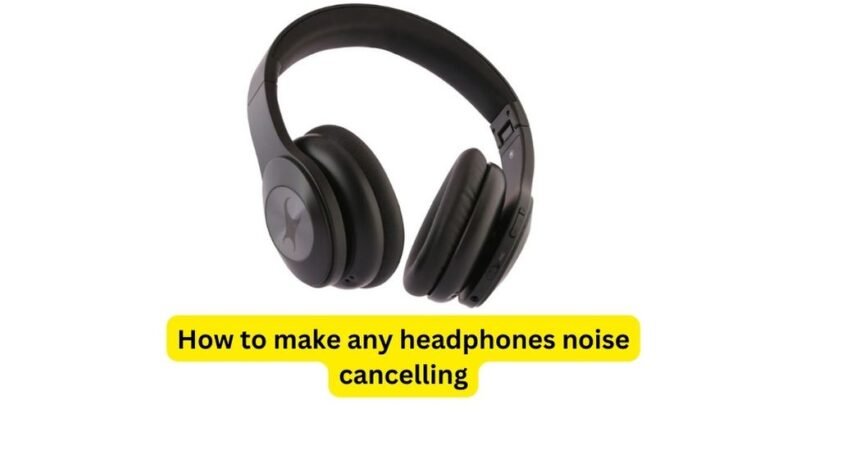Noise cancelling
How to make any headphones noise cancelling: In our previous article, we provided easy-to-follow tips on how to make any headphones noise-cancelling. But have you ever wondered what actually makes earphones noise-cancelling in the first place?
There are certain elements that are integrated into headphones during the design and manufacturing process. Here are a few of the key factors:
- Built-in microphones: These microphones analyze the ambient sound waves around you.
- Sound wave generation: Based on the analysis, the earphones generate opposite sound waves to cancel out the environmental noise.
- Neutralized external sound: This results in a more peaceful and enjoyable listening experience.
Understanding Noise Cancellation
Earphones with noise cancellation offer a welcome break from the din of everyday life. They are popular among audio enthusiasts and audiophiles for their ability to provide a more immersive listening experience.
There are two main types of noise cancellation:
- Active noise cancellation (ANC): This technology uses microphones to detect external sounds and then generates anti-noise signals to cancel them out. ANC is effective in reducing constant, low-frequency noises like engine hums.
- Passive noise cancellation: This method relies on physical barriers like ear cup padding to block out noise without using electronic components. Passive noise cancellation is ideal for reducing ambient sounds in a static environment.

How Noise-Cancelling Earphones Work
Noise-cancelling earphones use the following process:
- Microphone capture: Tiny microphones strategically placed in the earphones capture the symphony of sounds around you.
- Noise analysis: The noise is precisely processed and analyzed.
- Anti-noise signal generation: Based on the analysis, the earphones send signals to create an anti-noise wave for each disruptive note.
- Noise cancellation: The anti-noise waves meet the external sound waves and cancel each other out, resulting in a quieter listening experience.
It’s important to note that noise cancellation doesn’t completely block out all external noise. However, it can significantly reduce ambient noise, making it easier to focus on your music or podcast.
Benefits of Noise-Cancelling Earphones
There are many reasons why you might want to consider investing in a pair of noise-cancelling earphones:
- Crystal-clear audio: Noise cancellation allows you to hear your music with greater clarity and detail.
- Reduced stress and fatigue: Blocking out unwanted noise can help to reduce stress and fatigue, especially during travel or commutes.
- Improved concentration: Noise cancellation can help you to focus on tasks or studies by minimizing distractions.
- Personal audio sanctuary: Create your own personal audio sanctuary wherever you go, even in noisy environments.
Types of Noise Cancellation
As technology advances, new types of noise cancellation are emerging:
- Adaptive noise cancellation: This technology continually adjusts to the changing environment, offering a more dynamic and customized noise-cancelling experience.
- Hybrid noise cancellation: Combining both active and passive techniques, hybrid systems offer a comprehensive approach to noise reduction.
Considerations When Buying Noise-Cancelling Earphones
When choosing noise-cancelling earphones, consider the following factors:
- Battery life: Make sure the battery life is long enough for your needs, especially if you travel frequently.
- Comfort: You’ll likely be wearing your earphones for extended periods, so choose a pair that is comfortable and secure.
- Compatibility: Ensure the earphones are compatible with your devices.
Are Noise-Cancelling Earphones Worth the Investment?
While the price of noise-cancelling earphones may seem high initially, the benefits they offer can make them a worthwhile investment. They can improve your audio experience, reduce stress, and help you to focus.
DIY Noise-Cancelling Techniques
For those on a budget, there are alternative methods to achieve some noise reduction, such as using earplugs or homemade ear defenders.

Future Trends in Noise Cancellation Technology
The future of noise cancellation is promising, with new technologies and features being developed all the time. We can expect to see even more effective and personalized noise-cancelling experiences in the years to come.
User Experience and Feedback
User feedback is essential for understanding how noise-cancelling earphones impact people’s lives. Many users report experiencing
How noise-cancelling headphones work
It’s a popular misconception that ANC headphones cancel out all noises equally. They don’t. Active noise cancellation is generally more effective on lower frequencies of sound, such as the hum of a jet engine or an air conditioner. It’s not as successful with human voices and other higher frequencies.
The technology never works perfectly, but it can work well enough in certain environments to make listening more enjoyable. The best noise-cancelling headphones combine this “active” noise cancelling with passive noise reduction—that is, physical barriers and dampers built into the headphones that help block or absorb noise. If you want to learn more about how ANC works and what sounds it works on, check out “What Your Noise-Cancelling Headphones Can and Can’t Do.”
Additionally, more active noise cancelling doesn’t necessarily lead to a better experience. We say this because of a phenomenon we refer to as “eardrum suck,” which seems to produce the same uncomfortable reduction of pressure on the eardrums as you’re likely to experience when riding a high-speed elevator in a very tall building. And this sensation can lead to headaches or queasiness, especially in people who have sensory processing differences that involve the vestibular system. Typically, the headphones that create the most intense eardrum suck have a combination of very effective noise-cancelling circuitry and ineffective passive sound isolation. You can read more about this phenomenon in this blog post.


